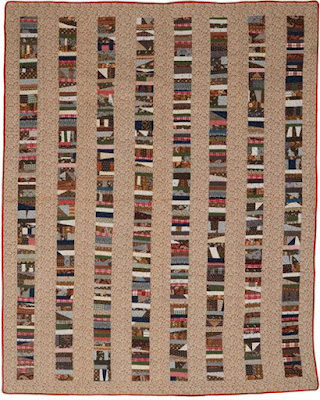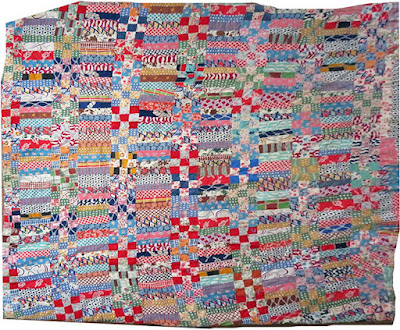Joyce Gross Collection
Dolph Briscoe Center for American History
Quilt attributed to Lucy Weeks Kendall (1858-1931), found in Oakland,
California, where it was probably made sometime between 1880 and 1900.
Born in Maine, Lucy Kendall and her family moved to California about 1880, living in Humboldt County, Berkeley and Oakland. Her brothers were well-to-do, enough so that she and Harry traveled to France about 1930 as the Great Depression began. Her sisters-in-law were listed in the social register. Lucy remained single, active in civic and religious groups with time to make this outstanding silk quilt.
The brothers made their money as partners in the lumber business but
there was a falling out---some jealousy over who had the nicer house?
Bowers Museum Collection
These stacked rectangles of various silk scraps
were a show quilt fashion at the end of the century.
When silk scraps were available as inexpensive factory cutaways.
There certainly was a style to these.
Scrappy with optional embroidery
The narrow pieces here may have been scraps of ribbon.
Plain strips optional too.
Wool quilt from an online auction
Once silk became hard to find and more expensive due to
trading issues with China in the early 20th century the pattern
was adapted to wools and cottons.
BlockBase #477
I'm surprised that the earliest published reference in my Encyclopedia
of Pieced Quilt Patterns is to Marie Webster's 1915 book where
she calls the design Roman Stripes.
She pictured a rather simple silk version.
Scrappy strips and a few cut from patchwork squares.
Amish quiltmakers found the design perfect
for their home sewing scraps
And created some eye-catching color studies.
American Museum of Folk Art
Sarah Miller, Haven, Kansas
We tend to call the pattern Chinese Coins today...
inspired by the way the coins stack up when threaded through
their center holes.
Possibly an Amish name for the design.
A 1979 reference to Chinese Coins from the Baltimore Sun.
Quilts in the design tend to range from organized stacks to wild abandon.
Most of these cotton strips in familiar early 20th-century prints.
Inez Lynn Daniels Austin, North Carolina
N.C. Project & the Quilt Index
From the late Laura Fisher's inventory
Stripes in strips....
And then you can just start adding strips
1940-1960
Another from Laura's inventory









































So much eye candy. I have always loved Joyce's super fancy strippy. These photos just make me want to cut all my fabric into strips. I should be done by 2025!
ReplyDeleteIsn't that the truth! I do love these quilts also.
DeleteOMG I think this is my favorite post of yours ever! I’m with Wendy. What amazing quilts, and inspiration for decades of sewing. And I’ve already cut up half my stash into strips!
ReplyDeleteI especially love that first one with the beautiful applique in opposite corners. But I see no evidence of quilting on these. Were they just beautiful spreads? One of these days I plan on making one with my 1800s reproduction fabrics.
ReplyDelete